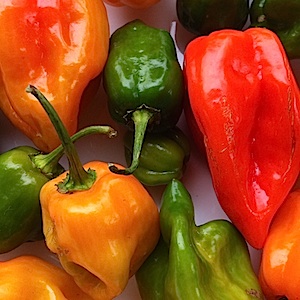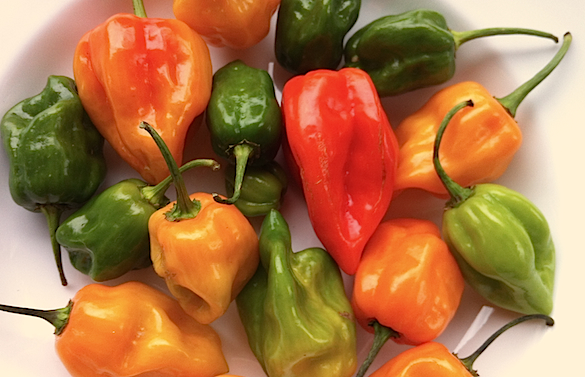Most of the time, I turn to different drugs at different times of the day. Caffeine in the morning, alcohol in the evening, and wedged between the stimulant and depressant, capsaicin at lunch. This array of self-medication is most often delivered respectively by capuccini, wine, and chillies. Actually, capsaicin is always delivered by chilli peppers in and of one form or another, since it’s the active ingredient in them that makes them ‘hot’. When people (my people) confess an addiction to chillies, they mean capsaicin, and although the confession is almost always delivered in a jokey way, I am convinced there’s more than a joke to it. We really and truly crave that burn, or at least it’s byproduct, the endorphin rush.
This week’s New Yorker is the ‘food issue’ and Lauren Collins’ piece, Fire-Eaters, is a romp through the weird world of super hot chilli breeders. It’s a great piece on its own terms, but completely misses the point of chilli enjoyment, which is a slow burn that just rides the difference between pleasure and pain. The trick in any dish is to provide enough heat to signal the brain to put out the endorphins. It’s not to blow the palate into outer space. Whether it’s Kimchi Stew or Buffalo Wings, the point is not to eradicate flavour, but enhance it. Chilli, like salt or lemon juice, is a seasoning. Of course, the effects of capsiacin are not confined to the palate or nervous system, they add a physicality to the act of eating, which has its own addictive drive. It’s very hard to maintain a serious conversation when one is slurping a really on spice bowl of Netsu Ramen, because every body system is locked into the capsaicin rapture that sizzling bowl delivers, however punctuated by alkaline noodle and other bits of goodness.
Of all the Columbian exchange foods to travel east, chillies seem to me to be the one that went native the deepest. Even more than potatoes in Ireland, or tomatoes in Italy, the chilli has made its way as an essential part of the pantry from the shores of the Mediterranean to the Indian Ocean and further onto the Eastern Coast of the Pacific: Korea is second only to Mexico in their consumption.
So, I am comforted in the knowledge that my capsaicin addiction is not lonely, nor particularly craven. Chillies are a super source of vitamin C, and other than a little tongue discomfort in the case of overdose, are not to modern science’s knowledge in any way detrimental to one’s health. I have not yet had a headache for not having a cup of capsaicin in the morning, nor a headache and a lot more bad feelings from having too many cups of capsaicin the night before.
I grow chillies all summer. Cayennes, bird’s eyes and Scotch Bonnets (or possibly Habaneros – I’m not sure since it’s the same species, and (apparently) the difference is in the shape, if one can be bothered to calibrate one’s chillies). With the frosts that hit this week, it was time to bring in the harvest. This peasant labour that I endeavoured was salved as it’s possible to pluck chillies while also holding a cup of cappuccino or a glass of wine.
Early in my food writing career, I interviewed Vikram Vij for the first time (of many to follow I am so glad to report). I asked him how Indians accommodated for different people’s, and specifically children’s, tolerance for chillies? He replied that chilli was generally served in India as a condiment at the table, and adults could take as much as they pleased. I follow this advice at my own table. I use my Cayennes and bird’s eyes to make a chilli infused olive oil. Alternatively, I like the fresh taste of Scotch Bonnet, so I make Bon Appetite’s simple mother sauce recipe for hot sauces, and keep it around to throw in or onto any luncheon dish that wouldn’t otherwise meet my fix. And, as the days grow shorter and temperatures decline, it’s good to have a bit of summer ready in the fridge, the thought of which might excite more endorphins than anything else, really. What better joy than the rush of good food?
 Malcolm Jolley is a founding editor of Good Food Revolution and Executive Director of Good Food Media, the company that publishes it. Follow him at twitter.com/malcolmjolley
Malcolm Jolley is a founding editor of Good Food Revolution and Executive Director of Good Food Media, the company that publishes it. Follow him at twitter.com/malcolmjolley







